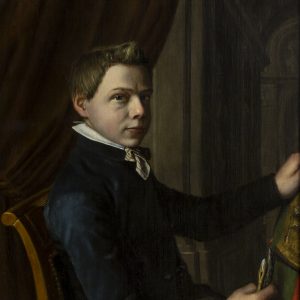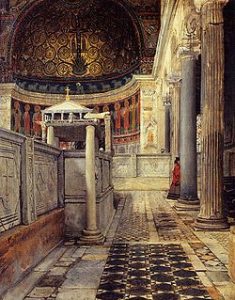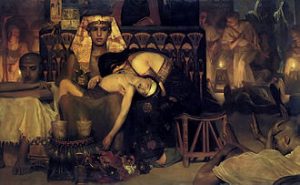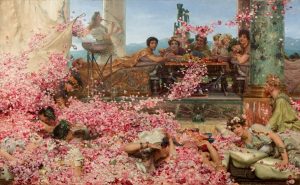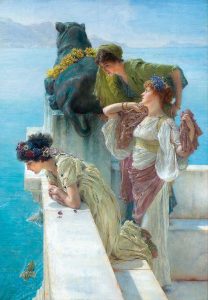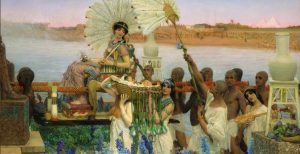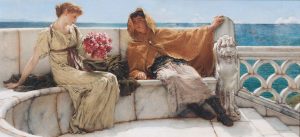Born in Friesland (the Netherlands), educated in Belgium, world-famous in England. The Fries Museum in Leeuwarden is the place to be to experience the voyage of discovery from Lourens Alma Tadema to Sir Lawrence Alma-Tadema. A tempting part of Leeuwarden-Fryslân European Capital of Culture 2018.
“I find it quite pleasant to paint them, so there are bound to be people who will find it pleasant to see them”. You bet, we are queuing up at the Fries Museum. Or we walk past the queue with a ticket bought online, the smart way.
Destiny of a talent
“A day not painted is a day not lived”, and in case of Lourens this is almost literally true. Born on 8 January 1836 in the Frisian village Dronryp, he breaks down mentally and physically as a teenager from the strain of combining his studies and painting. At the advise of doctors and with permission of his mother Hinke (already having lost his father Pieter at the age of four) he is allowed to pursue a life in arts. A few months after he finished his Self-portrait, he sets out in 1852 from Leeuwarden to Antwerp, just sixteen years old. His mother and his sister Artje follow a few years later.
In Antwerp he first studies at the Koninkelijke Academie voor de Schone Kunsten (Royal Academy for Fine Arts), before joining the historical painter and archaeology teacher Louis de Taeye as a private student. More and more he gets inspired by the much-praised painter Henri Leys, who eventually takes Lourens under his care in 1860. His meeting with import art-dealer Ernest Gambart subsequently opens up an eager market in England. Alma Tadema not only has a gift for drawing and painting, but is equally apt in surrounding himself with the right people to further advance his career.
The year 1863 is a tough but important year for Lourens Alma Tadema. It is the year his mother dies, but also the year he marries Marie-Pauline Gressin Dumoulin, born in a French and well-off family. They travel to Italy on their honeymoon and visit, among other places, Rome, Naples and Pompeii. This journey with Pauline marks the moment where Lourens is deeply affected by antiquity and decides to bring Roman history to life in his paintings, especially Roman daily life. In particular the visits to Pompeii and Herculaneum were important to him.
A very intimate and personal painting that was created during the honeymoon is Interior of the Church of San Clemente. Here we see Pauline being pictured while she is disappearing behind a column. The artist himself pops up from behind a wall. Lourens has always kept this painting in his own possession. In 1935 it came into the possession of the Fries Museum, along with many other personal belongings, replica’s, cloths, rugs, and other works of art, thanks to a gift of Alma Tadema’s daughter Laurence.
Alma Tadema doesn’t start working on a painting without thorough research. For an amateur he acquires an impressive amount of archaeological knowledge, also by studying and collecting books, engravings and photographs. He is quite possibly the best documented artist of his time. To this Henri Leys has been important, insisting on historical accuracy, especially in the reproduction of materials and cloths. Leys also encourages Lourens to experiment with unexpected composition plans by focusing not necessarily on the central theme, but ‘almost accidentally’ on things happening before, after, or around the event. As if the painting is a photograph or snapshot of a scene from a historical reality. Just like in real life, the main characters and subjects are not always in the centre of our field of vision, and important events sometimes escape our attention.
After Lourens’ and Pauline’s firstborn son dies only a few months after his birth in 1864, two daughters, Laurence and Anna, are born in 1865 and 1867 respectively. Domestic bliss is cut short dramatically when Pauline dies in 1869. That same year Alma Tadema’s greatest influence and role model Henri Leys also passes away. Traces of sorrow are clearly visible in The Death of the Pharaoh’s Firstborn Son, painted in 1872. The painting went on exhibition throughout Europe and received several awards, after which Alma Tadema buys it back from the art-dealer and keeps the painting among his personal possessions for the rest of his life.
Gentleman in England
Encouraged by art-dealer Gambart, Alma Tadema moves to London in September 1870, together with Laurence and Anna, and his sister Artje who looks after his daughers. On a previous visit to London he had already met Laura Theresa Epps, a young woman from a significant and well-connected family. He now offers Laura to become her personal art teacher. A year later, in 1871, they marry. The career of Lourens lifts off immediately in the British capital and he becomes one of the most celabrated and best paid artists of the day.
Alma Tadema always signed his paintings L. Alma Tadema, once in England however Lourens quite naturally became Lawrence and his second and last names paired. The double-barrelled name Alma-Tadema has a certain posh and nobiliary ring to it, but has a further advantage: filed under A of Alma his name and works are covered in indexes and catalogues ahead of T of Tadema. In 1873 Alma-Tadema is naturalised as a British citizen.
The unique interiors of his houses, designed, modelled and decorated by Lawrence and his family, first at Townshend House, later at Grove End Road, become pieces of art in themselves. His studios are not just practical and pleasant workshops, they are also inspirational sources for his paintings. Alma-Tadema has detailed copies of utensils, accessories and other items of everyday use made after examples and artifacts in the British Museum. The architecture in his paintings is the result of painstaking studies of perspective and drawn designs. The marble is painted with the same meticulous perfection as the attire and hair style of the individuals. There is so much to see in the paintings, that much detail, just look at The Roses of Heliogabalus. All those rose petals! Alma-Tadema draws, makes photographs and paints, “but once it’s finished, I am no longer an artist. Then I become a dealer”.
In his ‘Palace of Beauty’ at Grove End Road 17, St. John’s Wood, it is not all hard work and dedication. In letter and spirit of the inscription above the door: When friends meet, hearts warm, it is a coming and going at the residence of this small straightforward bon vivant. Future kings George IV and Edward VII and many dignitaries, colleagues, friends and acquaintances, including Hendrik Willem Mesdag and his wife Sientje, Georg Henschel, Oscar Wilde, Sir Arthur Conan Doyle, and a young Winston Churchill, all visit his home and studio, his soirees and parties.
The higher echelons of the British art society look upon Alma-Tadema as ‘one of them’ and he becomes a member of the Royal Academy. In 1899, at the occasion of Queen Victoria’s eightieth birthday, he receives a knighthood. Perhaps the highest honour Alma-Tadema received follows in 1905 when he is awarded the Order of Merit, an acclaim conferred to persons who have rendered exceptional services in armed services, or towards the advancement of science, arts and literature. Sir Lawrence Alma-Tadema RA OM, not bad for a Frisian lad from Dronryp. After his death on 25 June 1912 he is interred in the crypt of St. Paul’s Cathedral.
Costume balls of a marble painter
Rarely the gap has been so small between adoration and neglection, honouring and abusement as happened to Lawrence Alma-Tadema. Luckily for him, most of it after his death. All of a sudden he and his work are ‘bad taste’ and he becomes the most mocked and humiliated painter of the nineteenth century. ‘Kitsch’, ‘only suitable for chocolate boxes and biscuit tins’ and ‘costume balls for the Victorian elite’. Artists and art critics alike looked down on his work: ‘lifeless, soulless, cold and a gimmick for the well-to-do’.
Well, that’s one in the eye for us then. Personally I think some of his portraits and characters are so real and lifelike, you could easily fall in love with them. The creative force behind his success lay – and lies – in his power to convince us that people in Roman times do not differ from the British people in the Victorian age, and do not differ from us now. The paintings depict cheerful and carefree scenes out of the lives of anonymous and ordinary, albeit well-to-do inhabitants of Rome or Pompeii.
We are offered a tempting fantasy and escape from the dark daily existence, with all its social problems. The images of a life so many long for, but only few will live, is as relevant and recognisable to the Victorian public as to us. Alma-Tadema is really painting Victorians dressed as Romans, he is painting us. A ‘guilty pleasure’? Pleasure indeed, guilty as charged.
Just look again at the The Death of the Pharaoh’s Firstborn Son. Who isn’t touched and moved by the pain and sorrow of the pharaoh holding his dead son in his arms? Frozen and numbed, trying to keep his tears from flowing freely, only just succeeding. It is everything but soulless and cold. The lack of demonstrated emotions make the image so much more powerful and passionate. Stunned by grief. Lifeless and cold as loss and death. Yes, regarded this way, lifeless and cold indeed. And true.
Many of his critics further forget the extraordinary effects of light and innovative ‘photographic’ compositions, the multiformity of perspective and splendid panoramic views, passages and vistas (through vistas). The credible decoration of the spatial and dynamic scenes, rich in contrast and full of lively people, almost pull you into the paintings. The film industry has gratefully embraced it all. The way Alma-Tadema collected objects from antiquity and had replicas made for his paintings, props avant la lettre, filmmakers collect tableaux, scenes and details from his paintings for their films.
When an artist is famous, celebrated and favoured during a particular period in time, this will also make that artist valuable for the understanding of this period. In case of Alma-Tadema we are able to trace back the nineteenth century view on antiquity through his paintings. Thank goodness the world of art and public have all embraced the painter again. A fine example of the fluctuation Alma-Tadema’s cycle is provided by his painting The Finding of Moses of 1904. In that year Alma-Tadema sold the painting for nearly 10.000 USD, a fortune in those days. In the 1960’s it isn’t worth more than a thousand dollars (the painting at some point even gets sold for its frame, after which the painting was thrown away and luckily retrieved). In 2010 the painting was sold at auction for about 36 million USD. Priceless.
Whirling through the exhibition
Whirling and dancing, from left to right, here and there making a flip and loop, in this wonderful way we are guided through the exhibition rooms along themes and episodes from Alma-Tadema’s life. The exhibition paints the picture of the artist as storyteller. Many larger and smaller paintings of the little big painter, some of them world-famous, others less well known, are brought together and complemented by other objects and possessions of the artist and his family. This blog is of course never able to bring the life and works of Alma-Tadema to life, the exhibition in the Fries Museum, Alma-Tadema – classical charm, succeeds gloriously.
It is striking how many classic and traditional looking paintings he has created in his ‘Frisian and Belgian period’, paintings and compositions you may expect of contemporaries and the earlier famous Dutch masters. With Alma-Tadema you quickly come to think of the world-famous and wonderfully colourful, bright white and blue paintings. Typically these ‘classics’, his ‘Roman’ paintings are unconventional by their surprising compositions, scenes and themes that trigger our imagination and make the past come alive.
The attentive visitor will notice archaeological objects, replicas and pieces of cloth recurring in many of the photographs and paintings of the houses of Alma-Tadema and in his paintings. Within the exhibition this invites to a competition, counting how many times certain motives and objects are portrayed: replicas of Roman silver tableware, glass and pottery, the hides of a bear and tiger, furniture and his collection of cloth and fabric. Not only ‘dead’ elements recur repeatedly, so do his muses: Pauline, Laura and his daughters. All make regular appearances in his paintings, as themselves or as actors in one of his historical settings.
Indulge yourself
Lourens, or Lawrence, Alma-Tadema can be enjoyed at the Fries Museum until 7 february 2017, after which the exhibition will travel first to the prestigious Belvedere in Vienna, Austria, and then to Leighton House Museum in London. Relishing the memory – or in eager anticipation – is easy enough, at home on the sofa or in your favourite chair, with the splendid and informative book to the exhibition: Lawrence Alma Tadema: At home in Antiquity (edited by Elizabeth Prettlejohn and Peter Trippi). It is a valuable summary of the life, work, houses and muses of the man who painted a picture of antiquity that has influenced and is still influencing our image of the Roman period.
For all who have not yet had the chance to visit the exhibition, here’s a Spoiler Alert, or rather, the opposite: his critics were wrong. For a definite fact-check: indulge yourself and go visit the exhibition! As the artist said himself: “As the sun colours flowers, so art colours life”. His bright and cheerful disposition is everywhere to be found in his paintings. “Art, together with literature and music, is the flower of civilisation”, according to Alma-Tadema. And he is right.


 Nederlands
Nederlands